The cruiser "Varyag". After the ball…
About the fight has already been written so much that it simply makes no sense to repeat. But what was “after the ball”?
The battle that started at 11 hours 45 minutes ended at 12 hours 45 minutes. 425 6-inch caliber shells, 470 75-mm and 210 47-mm caliber shells were launched from Varyag, and 1105 shells were launched in total. In 13 hours 15 minutes "Varyag" anchored at the place where 2 appeared from an hour ago. There was no damage on the gun "Koreyets", as there were no dead or wounded. In 1907, in the pamphlet "The Battle of the Varyag" at Chemulpo ", V.F. Rudnev repeated word for word about a fight with a Japanese squad. The retired commander of the Varyag did not say anything new, but it was necessary to say.
Given the current situation, on the council of officers “Varyag” and “Korean” they decided to destroy the cruiser and gunboat, and bring the teams to foreign ships. The gunboat "Koreets" was blown up, and the cruiser "Varyag" was sunk, opening all the valves and kingstones. At 18 hours and 20 minutes he lay aboard. At low tide, the cruiser was exposed more than 4 meters. Somewhat later, the Japanese raised the cruiser, which made the transition from Chemulpo to Sasebo, where it was commissioned and sailed in Japanese for more than 10 years navy called "Soya" until the Russians bought it.
The reaction about the death of "Varyag" was not straightforward. Some naval officers did not approve of the actions of the Varyag commander, regarding them as illiterate both from a tactical point of view and from a technical point of view. But higher-level officials thought differently: why start a war with failures (especially since Port Arthur was a total failure), would it not be better to use the battle under Chemulpo to raise the national feelings of the Russians and try to turn the war with Japan into a people one. Developed a script meeting heroes Chemulpo. On the miscalculations all silent.
The senior navigator officer of the cruiser, E. A. Behrens, who became 1917 after the October Revolution, was the first Soviet chief of the Naval General Staff, later recalled that he had expected arrest and maritime court on his native shore. On the first day of the war, the Pacific fleet decreased by one combat unit, and so did the enemy’s forces. The news that the Japanese began to rise "Varyag", spread quickly.
By the summer of 1904, the sculptor K. Kazbek produced a model of a monument dedicated to the battle of Chemulpo, and called it “Farewell to Rudnev with“ Varyag ””. On the model, the sculptor depicted VF Rudnev, who was standing at the railroad carters, to the right of which was a sailor with a bandaged hand, and an officer was sitting behind his back with his head down. Then the model was made and the author of the monument to the "guarding" KV Isenberg. There was a song about "Varyag", which became popular. Soon the painting "Death of the Varyag" was painted. View from the French cruiser "Pascal". " Photo-shooters were released with portraits of commanders and images of "Varyag" and "Korean". But the ceremony of meeting the heroes of Chemulpo was especially carefully designed. Apparently, it should be said more in detail, especially since almost no one wrote about it in the Soviet literature.
The first group of warriors arrived in Odessa on March 19 of the year. The day was sunny, but the sea was very swell. In the morning the city was decorated with flags and flowers. The sailors arrived at the Tsar's pier on the steamer "Malaya". They were met by the steamer "Saint Nicholas", which, when it was found on the horizon, "Malaya" was decorated with colorization flags. This signal was followed by a volley from the coastal battery salute guns. From the harbor into the sea came a whole flotilla of ships and yachts.
On one of the ships were the head of the port of Odessa and several St. George Cavaliers. Climbing aboard the Malaya, the port commander handed the St. George awards to the Varangians. The first group included Captain 2 of rank V.V. Stepanov, Warrant Officer V.A. Balk, engineers N.V. Zorin and S.S. Spiridonov, doctor M.N. Hrabrostin and 268 of lower ranks. Around 2 hours of the day "Malaya" began to enter the harbor. Several regimental orchestras played on the shore, while a crowd of thousands of people met the ship with shouts of "Hurray."
The first to come ashore was Captain 2 of the rank of V. V. Stepanov. He was met by the priest of the seaside church, Father Atamansky, who presented the image of St. Nicholas, the patron saint of sailors, to the senior officer of the Varyag. Then the team went ashore. On the famous Potemkin Stairs leading to Nikolayevsky Boulevard, the sailors went upstairs and passed through a triumphal arch with an inscription made of flowers to the “Heroes of Chemulpo”. On the boulevard of the sailors were met by representatives of the city government. The mayor presented Stepanov with bread and salt on a silver platter with the emblem of the city and with the inscription: "Hello Odessa to the heroes of the Varyag who surprised the world."
A prayer service was served on the square in front of the Duma building. Then the sailors went to the Sabansky barracks, where a festive table was laid for them. Officers were invited to the cadet school at a banquet hosted by the military department. In the evening, the Varanians in the city theater showed a performance. In the 15 hours of March 20 on the steamer "Saint Nicholas", the warmers went from Odessa to Sevastopol. On the embankments again came the crowd of thousands.
On the approaches to Sevastopol, the steamer met the destroyer with a raised signal "Hello to the brave." The steamer "Saint Nicholas", decorated with flags of colorization, entered the Sevastopol raid. On the battleship Rostislav, his parish was greeted with 7 shots salute. The first commander of the Black Sea Fleet, Vice Admiral N. I. Skrydlov, was the first to board the ship.
Surpassing the line, he addressed the Varanzhans with a speech: "Great, family, congratulations on the brilliant feat in which they proved that the Russians know how to die; you, like true Russian sailors, surprised the whole world with your selfless bravery, defending the honor of Russia and St. Andrew’s flag, ready to die rather than give the enemy a ship. I am happy to greet you from the Black Sea Fleet and especially here in the long-suffering Sevastopol, a witness and keeper of the glorious military traditions of our native fleet. Here every piece of land is stained with Russian blood. Russian heroes' teniki: I bow low to you from all the Black Sea people, and I can’t resist not to thank you sincerely as your former admiral for the fact that you have so gloriously applied all your instructions to your exercises in battle! our welcome guests! "Varyag" died, but the memory of your exploits is alive and will live for many years. Hurray! "
A memorial service was served at the monument to Admiral P. S. Nakhimov. Then the chief commander of the Black Sea Fleet handed the officers the highest letters to the St. George crosses. It is noteworthy that for the first time St. George's crosses were awarded doctors and mechanics on a par with combat officers. Taking off the George Cross, the admiral pinned him to the captain's uniform of 2 of the rank of V. Stepanov. Varjazhtsev was stationed in the barracks of the 36 fleet crew.
The Tauride Governor asked the chief commander of the port that the Varyag and Koreytsky teams, while traveling to St. Petersburg, stopped for a while in Simferopol to honor the heroes of Chemulpo. The governor explained his request by the fact that his nephew Count A. Nirod was killed in battle.
At this time in St. Petersburg were preparing for a meeting. The Duma adopted the following procedure for honoring the Varangian:
1) at the Nikolaevsk railway station representatives of the city public administration, headed by the mayor and the chairman of the Duma, meet heroes, present bread and salt to the Varyag and Koreans commanders on artistic dishes, invite commanders, officers and class officials to the Duma meeting to announce greetings from cities;
2) the presentation of the address, artistically executed during the expedition of the preparation of state papers, setting forth in it the ordinance of the city council on honoring; giving all officers gifts for a total of 5 thousand rubles;
3) treats the lower ranks of lunch at the People’s House of Emperor Nicholas II; issuing to each lower rank a silver watch with the inscription “Hero of Chemulpo”, stamped with the date of the battle and the name of the person awarded (the watch was allocated from 5 to 6 thousand rubles, and for a treat of the lower ranks - 1 thousand rubles);
4) device in the People's House submission for the lower ranks;
5) the establishment of two scholarships in memory of the heroic deed, which will appoint students of maritime schools - Petersburg and Kronstadt.
6 April 1904 in the French steamer "Krimé" the third and last group of Varangians arrived in Odessa. Among them were captain 1 of rank V.F. Rudnev, captain 2 of rank G.P. Belyaev, lieutenants S.V. Zarubaev and P.G. Stepanov, doctor M.L. Banschikov, paramedic from the battleship Poltava, 217 sailors from Varyag, 157 from Korean, 55 sailors from Sevastopol and 30 Cossacks of the Trans-Baikal Cossack Division guarding the Russian mission in Seoul. The meeting was as solemn as the first time. On the same day, on the steamer "Saint Nicholas", the heroes of Chemulpo went to Sevastopol, and from there 10 of April by the Kursk Railway emergency train - to St. Petersburg via Moscow.
14 April in a huge area near the Kursk railway station, residents of Moscow met the sailors. The orchestras of the Rostov and Astrakhan regiments played on the platform. V. F. Rudnev and G. P. Belyaev were presented with laurel wreaths with inscriptions on white-blue-red ribbons: “Hooray to the brave and glorious hero - the commander of the“ Varyag ”” and “Hurray to the brave and glorious hero - to the commander of the Korean,”. All officers were presented with laurel wreaths without inscriptions, and the lower ranks were given bouquets of flowers. From the station, the sailors headed to the Spassky barracks. The mayor handed the officers gold tokens, and the ship’s priest "Varyag" father Mikhail Rudnev received a golden neck symbol.
16 April at ten o'clock in the morning they arrived in St. Petersburg. The platform was filled with meeting relatives, military, representatives of the administration, nobility, zemstvos and townspeople. The meeting included the Vice-Admiral F. K. Avan, the Marine Department Manager, and Rear-Admiral 3, Chief of the Main Naval Staff. P. Rozhestvensky, his assistant A. G. Niedermiller, Chief Commander of the Port of Kronstadt, Vice Admiral A. A. Birilev, Chief Medical Inspector of the Navy, Life-surgeon V. S. Kudrin, Petersburg Governor, Stallmeister O. D. Zinoviev, Provincial Leader of the Nobility Count VB Gudovich and many others. Grand Duke General-Admiral Alexey Alexandrovich arrived to meet the heroes of Chemulpo.
A special train approached the platform at exactly 10 hours. A triumphal arch, decorated with a state emblem, flags, anchors, St. George ribbons, etc., was erected on the station platform. the palace. Rows of soldiers, a huge number of gendarmes and mounted police barely restrained the onslaught of the crowd. Officers were ahead, followed by the lower ranks. Flowers poured from the windows, balconies and roofs. Through the arch of the General Staff, the heroes of Chemulpo came to the square near the Winter Palace, where they lined up opposite the royal entrance. On the right flank were the Grand Duke General-Admiral Alexey Alexandrovich and the head of the Marine Ministry, Adjutant-General F. K. Avélan. Emperor Nicholas II came to the Varangian people.
He accepted the report, went around the line and greeted the sailors of the Varyag and the Koreytsa. After that, they marched in a ceremonial march and proceeded to the St. George Hall, where the service was held. For the lower ranks in the Nikolaevsky Hall laid the tables. All the dishes were with the image of St. George's crosses. In the concert hall laid a table with a golden service for the highest persons.
Nicholas II addressed the heroes of Chemulpo with a speech: "I am happy, brothers, to see you all healthy and safely returned. Many of you brought with your blood into the annals of our fleet a work worthy of the exploits of your ancestors, grandfathers and fathers who made them in Azov "and" Mercury "; now you have added a new page in your exploit history of our fleet, we added the names of "Varyag" and "Korean" to them. They will also become immortal. I am confident that each of you until the end of his service will remain worthy of the reward that I gave you. All Russia and I, with love and anxious excitement, read about the exploits that you showed at Chemulpo. I sincerely thank you for supporting the honor of the flag of St. Andrew and the dignity of the Great Holy Russia. I drink to further victories of our glorious fleet. For your health, brothers! "
At the officers' table, the emperor announced the establishment of a medal in memory of the battle at Chemulpo for wearing by officers and lower ranks. Then a reception was held in the Alexander Hall of the City Duma. In the evening, everyone gathered in the Folk House of Emperor Nicholas II, where a gala concert was given. The lower ranks were handed gold and silver watches, handed out spoons with silver cuttings. Sailors received a brochure "Peter the Great" and a copy of the address from the St. Petersburg nobility. The next day, the teams went on their own crews. The whole country learned about such a magnificent celebration of the heroes of Chemulpo, and, therefore, about the fighting "Varyag" and "Korean". The people could not appear even a shadow of doubt in the believability of the perfect feat. True, some naval officers doubted the accuracy of the description of the battle.
Fulfilling the last will of the heroes of Chemulpo, the Russian government in 1911 addressed the Korean authorities with a request to allow the ashes of the dead Russian sailors to be transferred to Russia. 9 December 1911. A mourning procession headed from Chemulpo to Seoul, and then by rail to the Russian border. Throughout their journey, the Koreans showered the platform with the remains of sailors with fresh flowers. December 17 mourning procession arrived in Vladivostok. The burial of the remains took place at the Sea Cemetery of the city. In the summer of 1912, an obelisk of gray granite with St. George's Cross appeared over the mass grave. On its four sides were the names of the dead. As it was supposed, the monument was built on public money.
Then about "Varyag" and the varjazhtsy were forgotten for a long time. Remembered only through 50 years. 8 February 1954 issued a decree of the Presidium of the Supreme Soviet of the USSR "On awarding the sailors of the cruiser Varyag with the medal" For Courage ". At first, only 15 people were found. Here are their names: V. F. Bakalov, A. D. Wojciechowski, D. S. Zalideev, S. D. Krylov, P. M. Kuznetsov, V. I. Krutyakov, I. E. Kaplenkov, M. Ye. Kalinkin, A.I. Kuznetsov, L.G. Mazurets, P.E. Polikov, F.F. Semenov, T.P. Chibisov, A.I. Shketnek and I.F. Yaroslavtsev. The oldest of the Varanzhans, Fedor Fedorovich Semenov, turned 80 years old. Then found the rest. 1954-1955 total The medals were awarded to 50 sailors from Varyag and Koreans. In September, 1956 was opened in Tula a monument to V. F. Rudnev. In the newspaper "Pravda" the fleet admiral N. G. Kuznetsov wrote these days: "The feat of" Varyag "and" Koreyets "entered the heroic history of our people, into the golden fund of the combat traditions of the Soviet fleet."
There are, however, a number of questions. The first question: for what merits so generously rewarded all without exception? Moreover, officers of the Koreyan cannon boat first received another orders with swords, and then simultaneously with the Varangian (at the request of the public), they also received the Order of St. George of the 4 degree, that is, for one feat they were awarded twice! The lower ranks received the insignia of the Military Order - the crosses of St. George. The answer is simple: Emperor Nicholas II didn’t want to start a war with Japan with defeats.
Even before the war, the Admirals of the Naval Ministry reported that they would destroy the Japanese fleet without much difficulty, and if necessary, they could "arrange" the second Sinop. The emperor believed them, and here at once such bad luck! Under Chemulpo, the newest cruiser was lost, and near Port Arthur the ship’s 3 was damaged - the battleships Tsarevich, Retvizan and the cruiser Pallas. Both the emperor and the Navy Ministry "covered" this mistake and misfortune with this heroic sensation. It turned out believable and, most importantly, pompous and effective.
The second question: who "organized" the feat of "Varyag" and "Korean"? The first people called the battle heroic two people - the vicegerent of the emperor in the Far East, Adjutant General Admiral E. A. Alekseev and Vice-Admiral O. A. Stark, senior flagship of the Pacific Squadron. The whole situation testified that war with Japan was about to begin. But they, instead of preparing to repel the surprise attack of the enemy, showed complete carelessness, or rather, criminal negligence.
Fleet readiness was low. The cruiser "Varyag" they themselves had driven into a trap. To accomplish the tasks that they set for station ships at Chemulpo, it was enough to send the old gunboat "Koreyets", which did not represent special combat value, and not to use the cruiser. When the Japanese began to occupy Korea, they did not draw any conclusions for themselves. VF Rudnev also did not have the courage to make a decision about leaving Chemulpo. As you know, the initiative in the fleet has always been punishable.
Due to Alekseev and Stark in Chemulpo, the Varyag and Koreets were left to the mercy of fate. Curious detail. When conducting a strategic game in the 1902 / 03 school year in the Nikolaev Maritime Academy, this situation was lost: in the case of a sudden attack by Japan on Russia, a cruiser and a gunboat were left uncached in Chemulpo. In the game, the destroyers sent to Chemulpo will report the start of the war. The cruiser and the gunboat have time to connect with the Port Arthur Squadron. However, in reality this did not happen.
Question three: why did the commander of the Varyag refuse to break through from Chemulpo and did he have such an opportunity? A false sense of camaraderie worked - "die yourself, but help a comrade out." In the full sense of the word, Rudnev began to depend on a low-speed "Korean" who could reach speeds of no more than 13 nodes. Varyag also had a speed of more than 23 nodes, which is more on 3-5 nodes than on Japanese ships, and on 10 nodes more than on Koreans. So there were good opportunities for an independent breakthrough for Rudnev. On January 24, Rudnev became aware of the severance of diplomatic relations between Russia and Japan. But January 26 morning train Rudnev went to Seoul to the envoy for advice.
When he returned, he only sent 26 minutes to 15 on January 40 with a report to the Port Arthur gunboat "Korean". Again the question: why was the boat so late sent to Port Arthur? This is still unexplained. The Japanese did not release the gunboat from Chemulpo. This war has already begun! Rudnev had one more night left, but did not use it either. Subsequently, the refusal of an independent breakthrough from Chemulpo Rudnev explained the difficulties of a navigational nature: the fairway in the port of Chemulpo was very narrow, winding, and the outer raid was full of dangers. Everyone knows that. Indeed, entry into Chemulpo in low tide, that is, during a low tide, is very difficult.
Rudnev didn’t seem to know that the height of the tides at Chemulpo reaches 8-9 meters (the maximum height of the tide to 10 meters). With the draft of the 6,5 cruiser meter into full evening water, it was still possible to break through the Japanese blockade, but Rudnev did not use it. He stopped at the worst option - to break through during the low tide and together with the "Korean." What this decision led to, we all know.
Now about the fight itself. There is reason to believe that the artillery was not used quite correctly on the Varyag cruiser. The Japanese had a huge superiority in strength, which they successfully implemented. This is evident from the damage that "Varyag" received.
According to the Japanese themselves, in the battle of Chemulpo their ships remained unharmed. In the official edition of the Japanese Naval General Staff "Description of military operations at sea in 37-38 Meiji (in 1904-1905)" (v. I, 1909) read: "In this battle, the enemy shells never hit to our courts and we have not suffered the slightest loss. " But the Japanese could lie.
Finally, the last question: why did Rudnev not put the ship out of operation, and sank it with a simple discovery of the Kingston? The cruiser was essentially "donated" to the Japanese navy. The motivation of Rudnev, that the explosion could damage foreign ships, is untenable. Now it becomes clear why Rudnev resigned. In the Soviet editions, the resignation is explained by Rudnev’s involvement in revolutionary affairs, but this is a fiction. In such cases in the Russian fleet with the production of rear admirals and with the right to wear the uniform did not dismiss. Everything is explained much more simply: the naval officers did not accept Rudnev into their corps for the admitted misses in the battle at Chemulpo. Rudnev himself realized this. At first he was temporarily in the position of commander of the battleship Andrei Pervozvanny under construction, then he filed a resignation report. Now, it seems, everything fell into place.
It turned out not very beautiful. Not like in the legend. But it turned out the way it happened. In my opinion, it was the first Russian action of “black PR”. But not the last. Our history knows many examples when the stupidity, indecision and cowardice of commanders were paid for in blood by soldiers and sailors.
Used materials of the article V.D. Dotsenko "Cruiser" Varyag "- unknown pages of history"
The cruiser Varyag - Soya.
During World War I, the Russian Empire and Japan became allies. In 1916, the cruiser "Soya" (along with a number of other ships) was bought by Russia. 4 April, the Japanese flag was lowered and the 5 April 1916, the cruiser was transferred to Vladivostok. After that, under the former name "Varyag" was included in the flotilla of the Arctic Ocean (made the transition from Vladivostok to Romanov-on-Murman) as part of the detachment of special purpose ships under the command of Rear Admiral Bestuzhev-Rumin
The cruiser Varyag after landing on stones near the village of Lendelfoot in Scotland, 1920
In February, 1917 of the year went for repairs to the UK, where it was confiscated by the British, because the Soviet government refused to pay for repairs. In 1920, resold to German companies for scrap. In 1925, when towing, the ship hit a storm and sank off the coast in the Irish Sea. Part of the metal structures was then removed by local residents. Was subsequently blown up
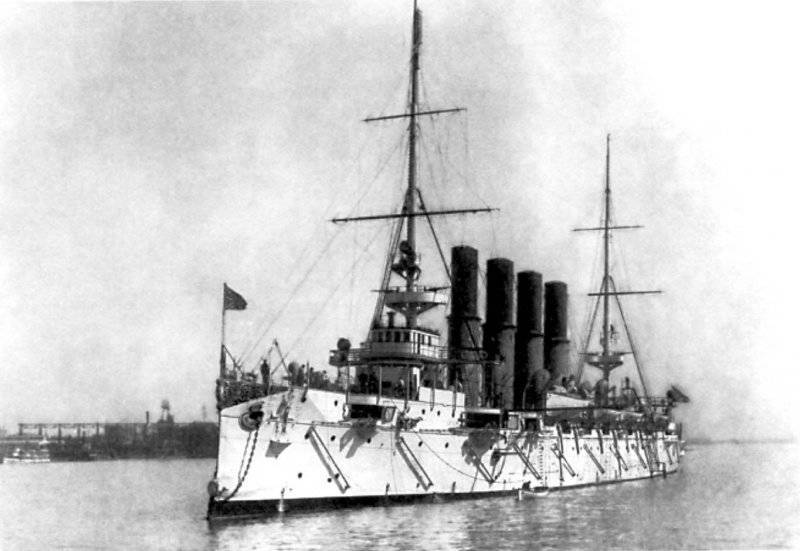
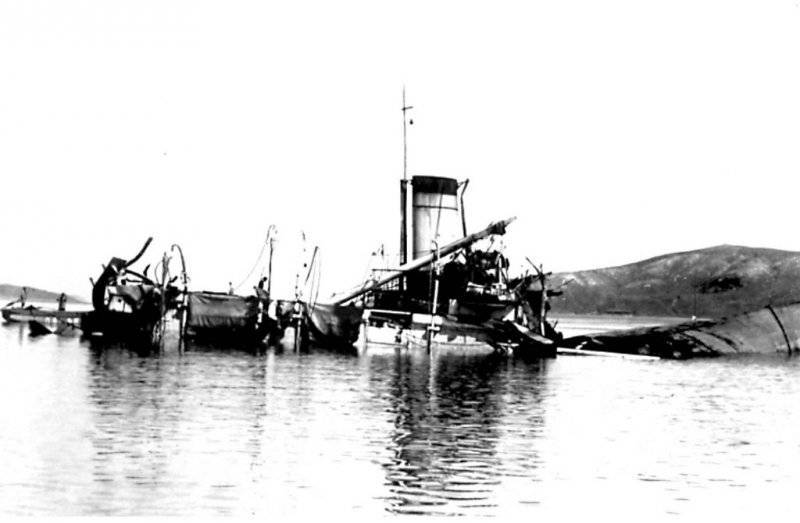
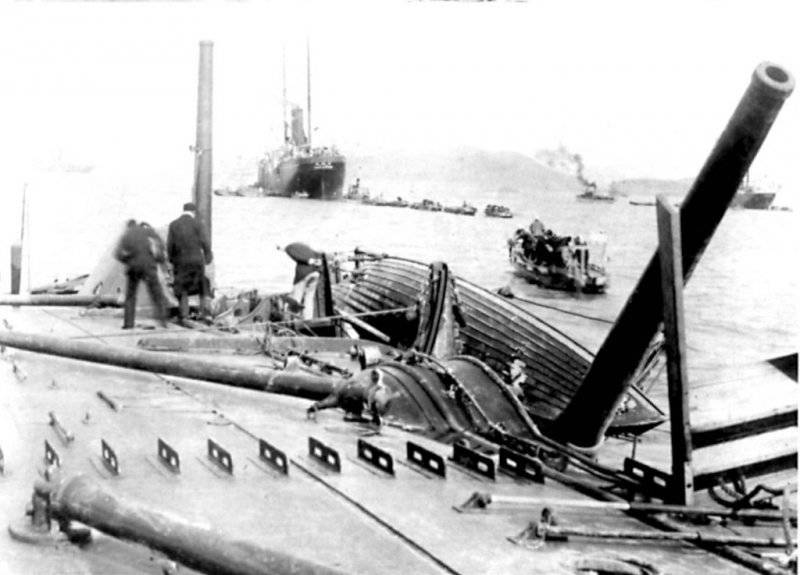
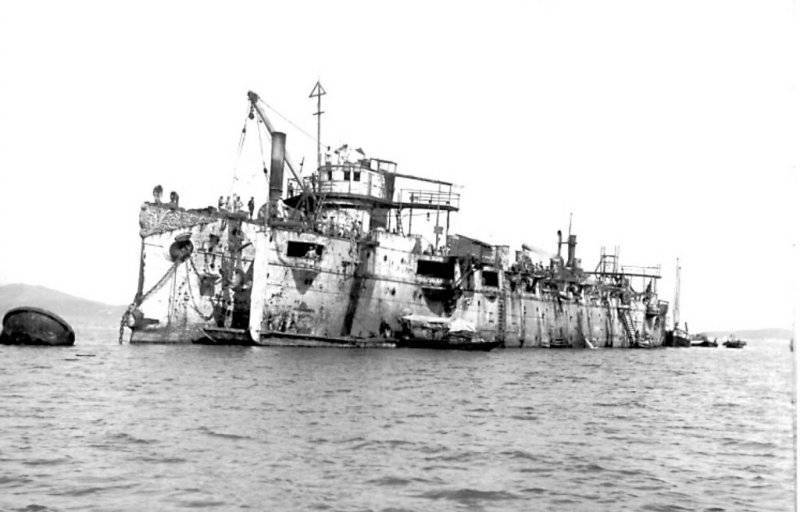
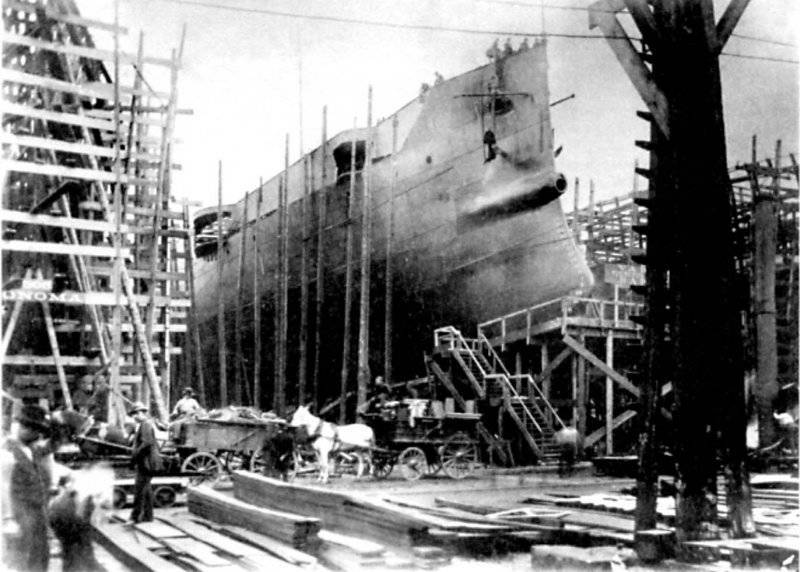
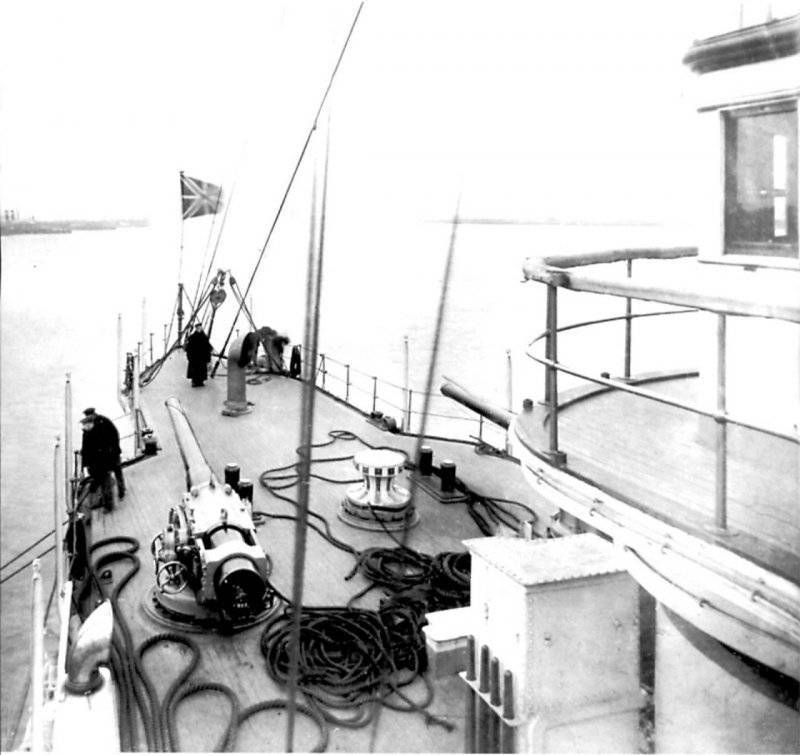
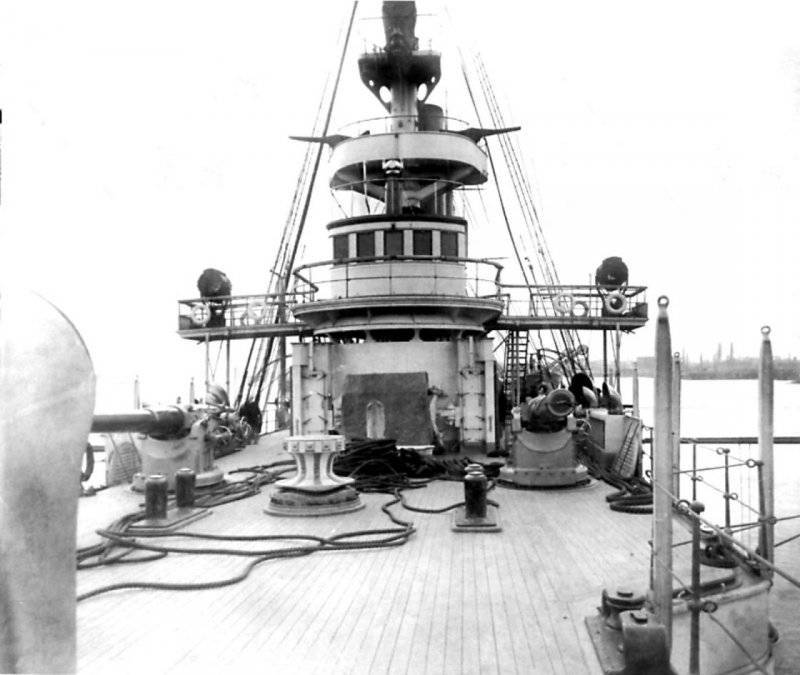
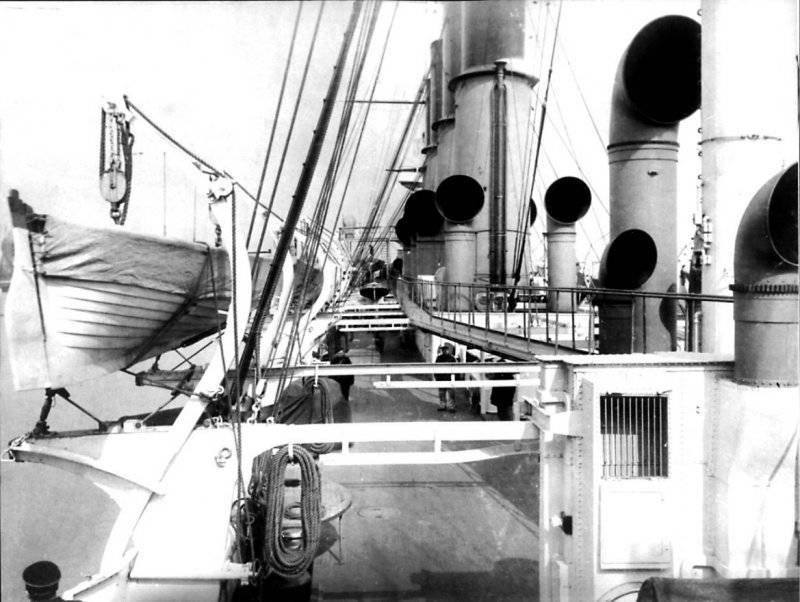

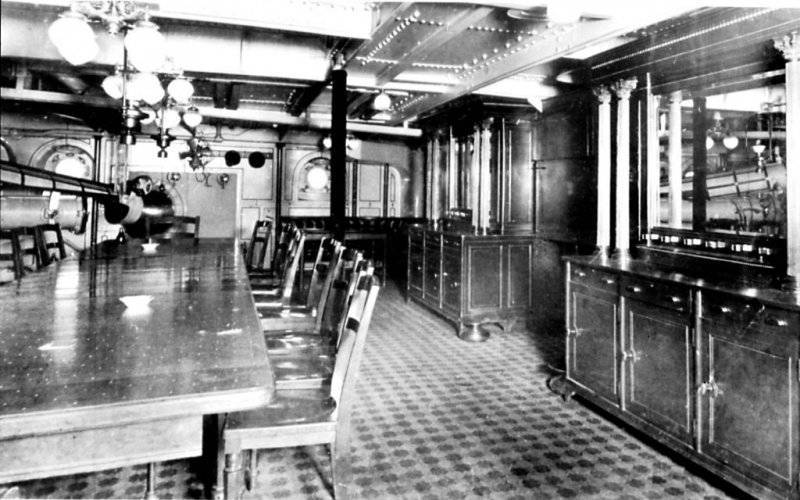
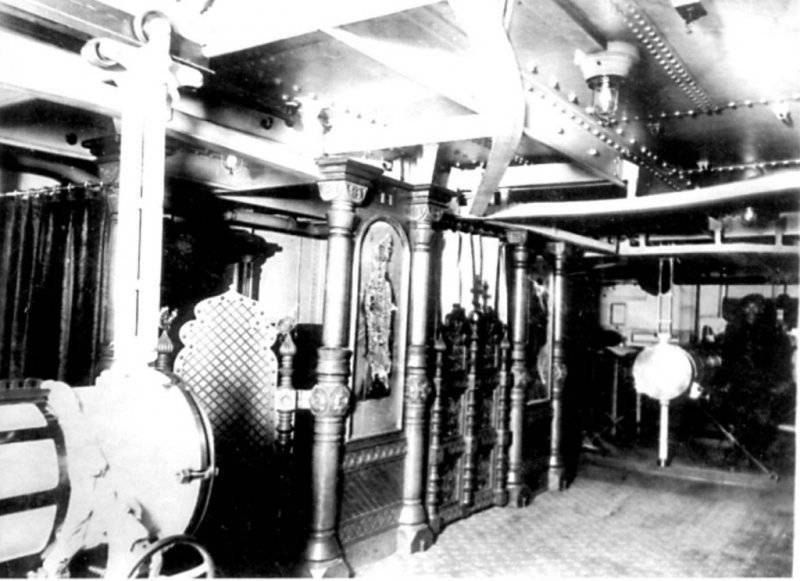
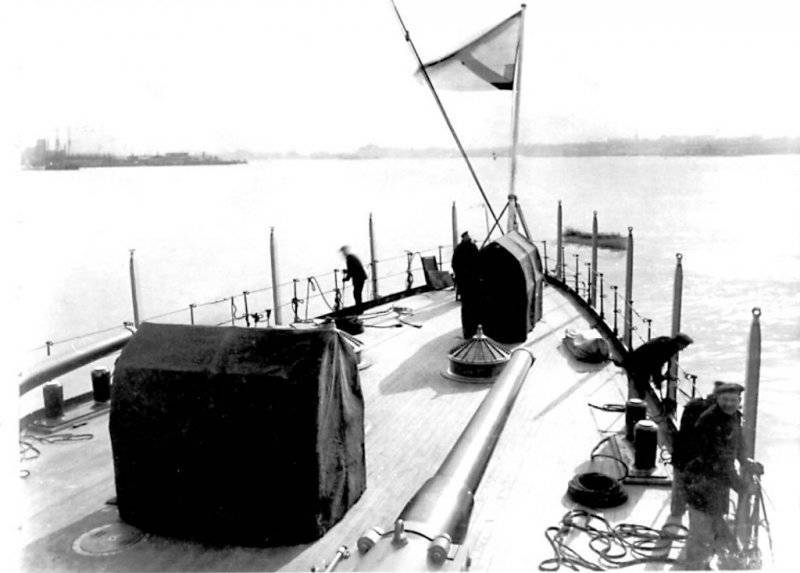
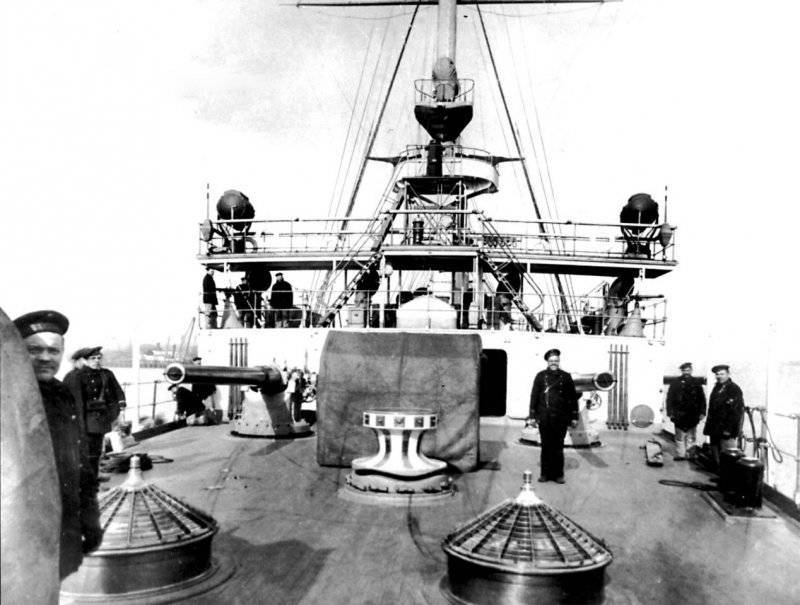
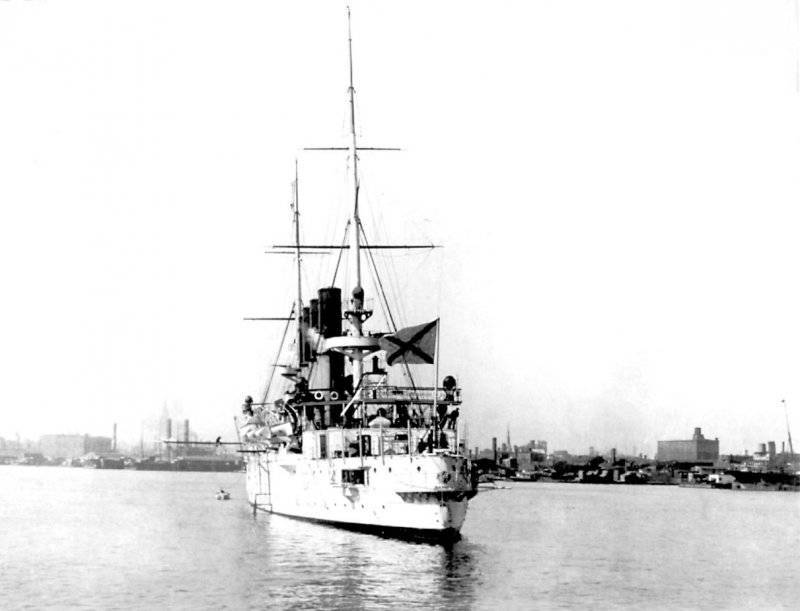
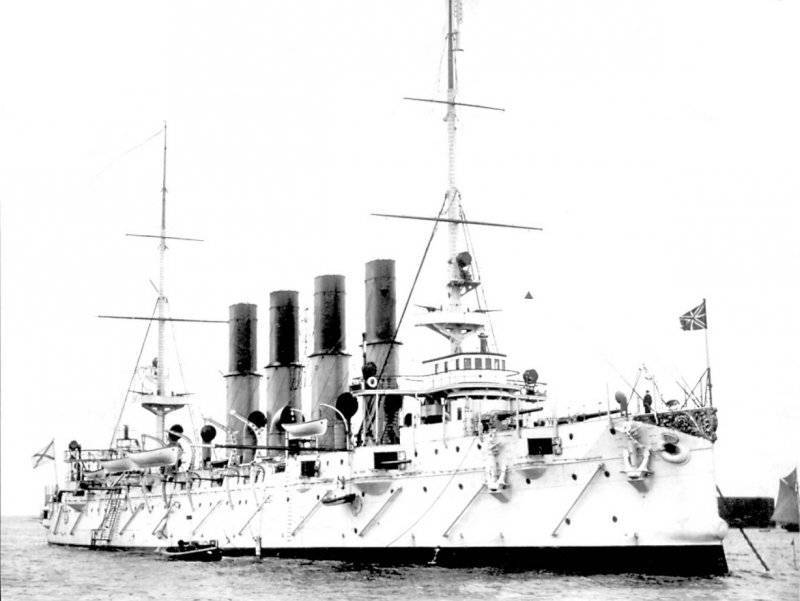
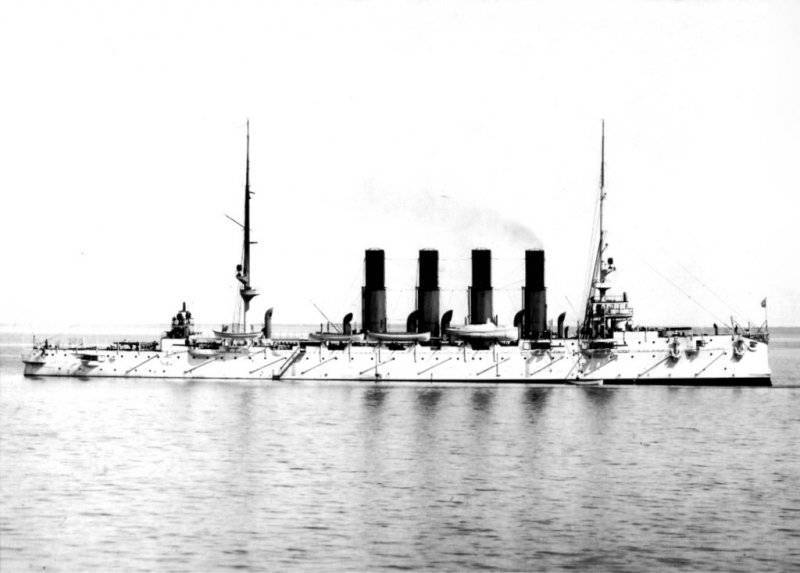
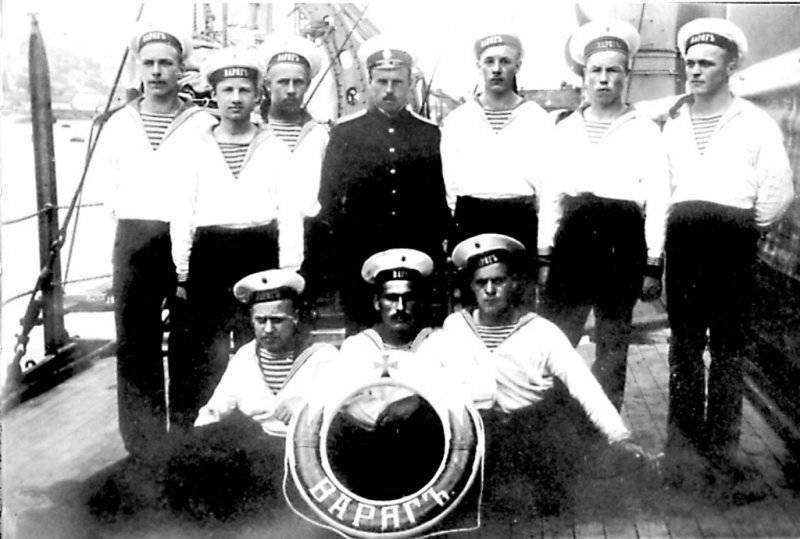
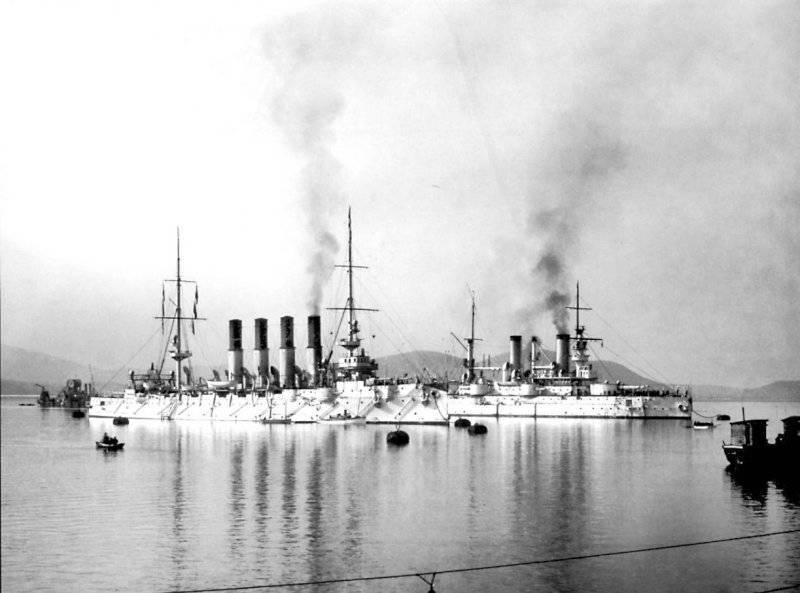
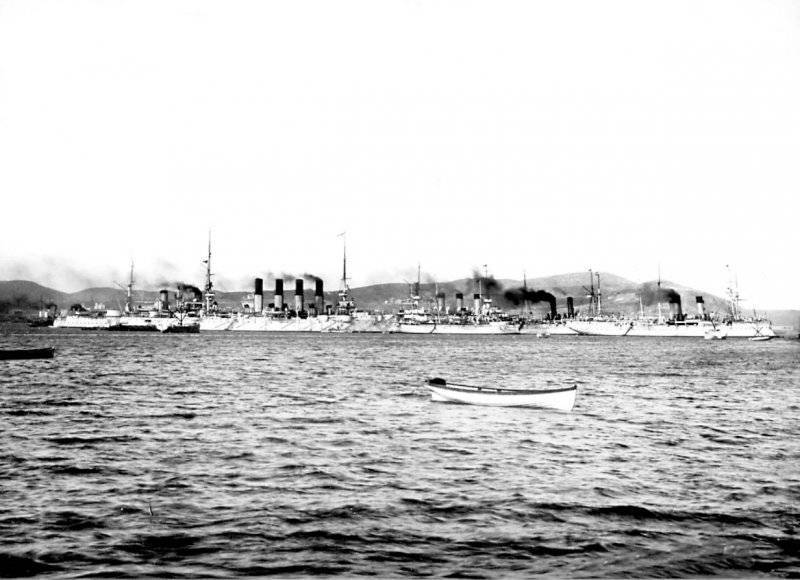
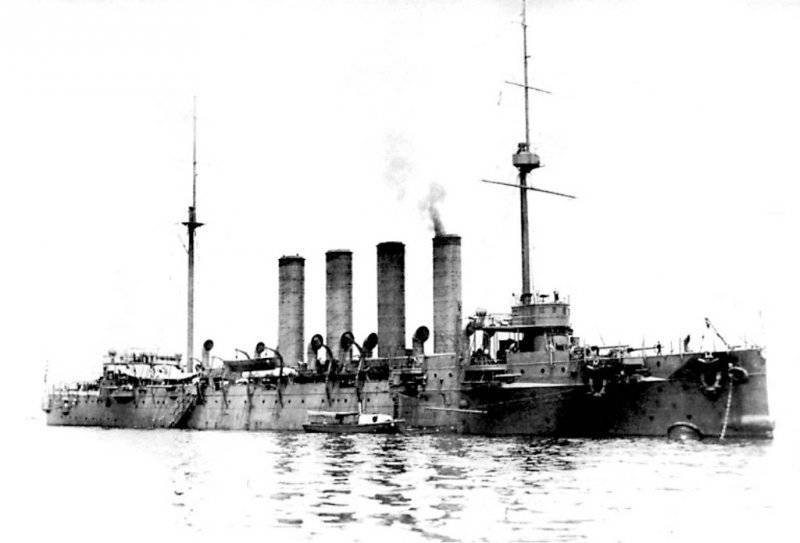
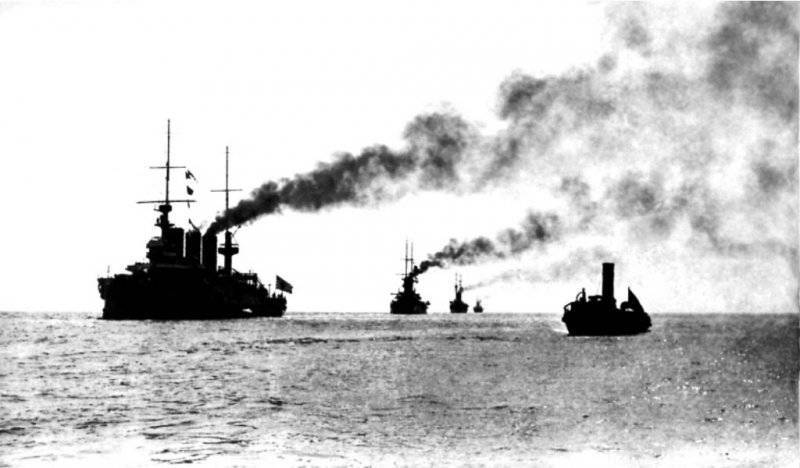
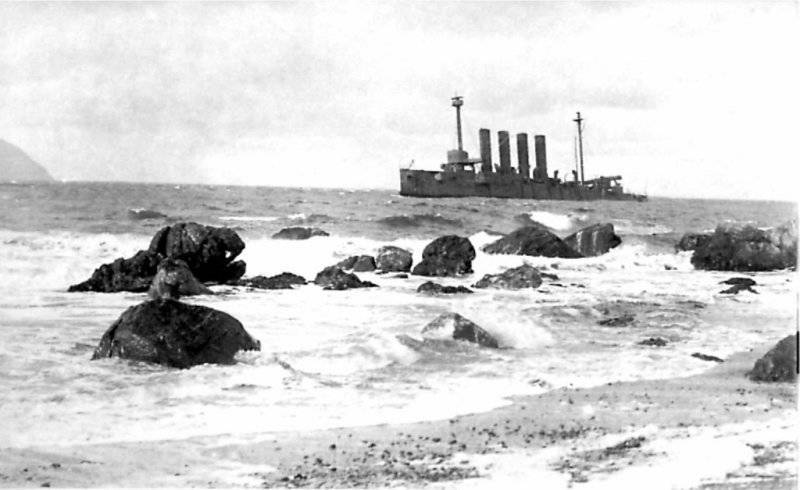
Information